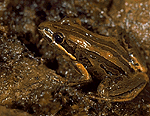Striped Marshfrog

Common name: striped marshfrog
Scientific name: Limnodynastes peronii
Family: Limnodynastidae (Australian ground frogs)
Conservation status: The striped marshfrogfrog is listed as Least Concern in Queensland (Nature Conservation Act 1992).
Description
The striped marshfrog is a medium to large sized frog. A large female can reach the size of a clenched fist (about 65mm in length). In contrast, the male striped marshfrog gets no bigger than a standard match box at around 40mm in length.
The top of the frog is marked with a series of dark and light brown stripes which break up into blotches on the sides of the frog. A white or pale yellow raised fold runs from below the eye to the shoulder. The underside is white. As with a number of native frog species they are sometimes called “rocket frogs” because of their pointed nose.
Habitat and distribution
The striped marshfrog is widespread and an adaptable frog found in a variety of habitats from flooded pasture and suburban gardens to forested wetlands. They prefer the moist open forest and woodlands, Melaleuca forests, and heathlands of eastern Queensland. Commonly found around farm dams, quarries and road side ditches as well as in natural ponds which retain water for extended periods.
They occur from South Australia and Tasmania along the east coast to Cape York. There are three disjunct populations in Queensland: Wet Tropics, Central Queensland Coast and south east Queensland, with an outlying population in the sandstone areas of the Carnarvon Ranges and Blackdown Tableland.
Life history and behaviour
The call of the striped marshfrog, a single 'plonk' or 'toc' like a hammer striking an anvil, or a drop hitting water, is repeated at intervals of a few seconds. Males can be heard calling in most months of the year except deep winter. Males call while submerged in water beneath overhanging vegetation. Breeding is in the spring and summer months. Dark brown eggs are laid in foam nests on the water surface during spring and summer.
Listen
Listen to an audio clip of the striped marshfrog (MP3, 142KB)†.
† Requires an appropriate media player.


